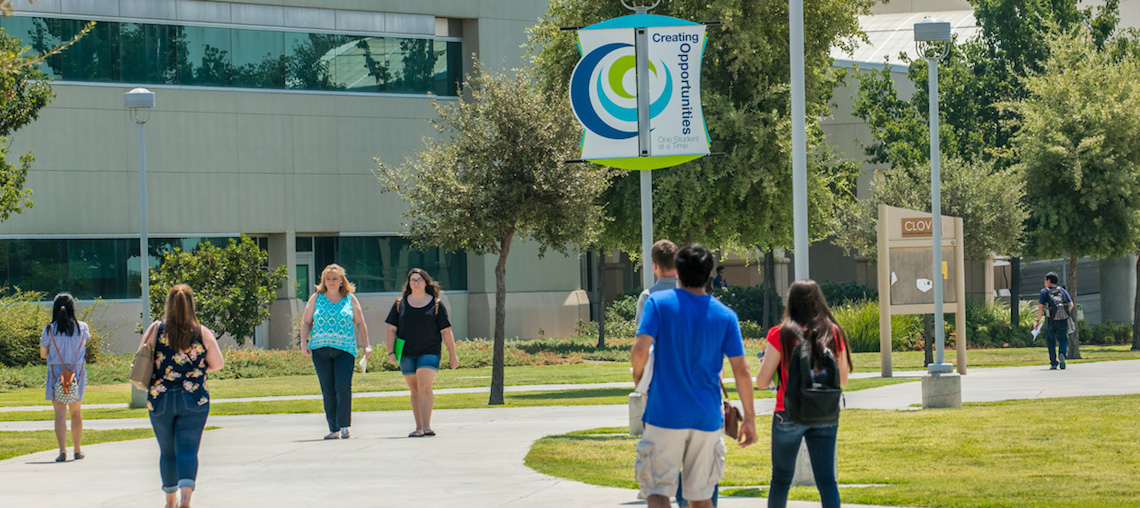
Students walk on campus in this Clovis Community College photo.
Written by Breanna Hardy
College enrollment has taken a dip at the national level, and in the Central Valley, community colleges are studying who is stepping back from their education and why.
According to a November 2021 study by the National Student Clearinghouse Research Center, community colleges saw a 15% decrease in enrollment since fall 2019.
As the newly installed chancellor of State Center Community College District, Dr. Carole Goldsmith has taken initiative to start a chancellor’s commission to find out why students left the district during the pandemic.
Goldsmith and her colleagues have found that decreased enrollment didn’t fall under one specific socioeconomic class or ethnicity. Rather, it was specifically pointing to a decrease in men ages 18 to 24 – in all ethnicity groups – showing up to class. The same National Student Clearinghouse Research Center study reflects this phenomenon.
“We started looking at things around gender lines, and what we found is that our young men are not returning at the same rate of our young women,” Goldsmith said.
The decline in enrollment is steady across other demographic groups except for this 18-to-24-year-old men category, which is seeing a steeper decline.
It’s not a new phenomenon. The decline in young men enrolled in college has dated back decades. In the 1970s, men represented about 60% of the student population. Women represented about 40%.
“By 2019 it almost flip-flopped. That was before the pandemic,” she said. “And that’s not because more women came to college. It’s because less men started going.”
The concern is about the future workforce.
“We cannot afford to lose a generation of young men,” Goldsmith said.
The Chancellor’s Commission on Engagement on Men will involve college, faculty and community leaders. It will also involve talking with students in this age and gender bracket to find the reasons.
“Are they going more to work? Perhaps, but we don’t know that for sure because we talk to our employers and they’re saying no because they’re having a hard time getting workers,” she said.
It will take a lot of collaboration to look at this phenomenon, she said. Employers and community leaders who wish to be part of the commission should contact the chancellor’s office.
Possible outcomes of the short study will include expanding the work-study program or producing a different way of outreach.
“We’re going to need to look at this in a very holistic and inclusive manner,” Goldsmith said.
Dr. Malisa Lee, associate vice president for enrollment management, says that at Fresno State enrollment has been better than anticipated throughout the pandemic, though the university is starting to see the impact of lower community college enrollment now.
Lee said that in fall 2020, Fresno State saw a record class – a large number of incoming students and a large number of students retained.
“It was a record year for us even in a pandemic,” Lee said.
For Fall 2021, there was a slight decline in enrollment, specifically in transfer students. She said it reflects the decline in enrollment at community colleges.
“Our pipeline from the community colleges to the four-year, to Fresno State – we’re recognizing the impact now,” she said.
Freshmen college applications have still come in strong, while transfer applications have declined. There was a lag in getting the applications in this year, though. In December, Fresno State gave a two-week extension to submit applications for fall 2022. The extension paid off, leveling freshmen applications with previous years.
Being in class virtually or in person largely impacts whether a student commits to the university, Lee said.
“It’s more than just the application, it’s attracting students to choose to apply to Fresno State. But when they get admitted to Fresno State, that they actually choose to come to us,” Lee said.
It’s a difficult feat though. When the school year began, the university couldn’t have known that the spring 2022 semester would start out virtually, Lee said. The announcement for temporary virtual classes due to the new Omicron variant was announced just last week.
“Students are asking that before they apply,” she said.
At both Fresno State and area community colleges, interest in health care majors has remained steady. Those courses are largely hands-on and require student time on campus.
Goldsmith pointed out that the students who stay are persistent, and it shows in Clovis Community College and Fresno City College’s record-breaking graduation rates. But Lee says the demographic shows up disproportionately at the university level.
Lee said she and her colleagues are having conversations about the students who have gotten lost in the mix since the pandemic. Many first generation college students lack support or resources to navigate going to college solely online.
“Those are the students that are most harmed in this process. And there’s going to be a need for us to kind of go back out as things go back to normal, and see if we can help bring them back and make sure that they’re included,” Lee said. “There’s definitely some equity issues now that we’re noticing in regards to who’s succeeded and who’s not.”
But the education sector has realized the value of collaborating to figure out a solution, Lee said.
“I see that as our new future – a lot of collaboration in how do we streamline the transfer process,” Lee said. “A lot of these conversations are happening now in preparation for more students coming.”








